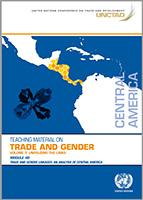
Central American countries have diverse linguistic, ethnic and economic structures, even though they share a geographic region and a common language (Spanish). Despite the diversity across the region, gender norms and stereotypes play an influential role in shaping people’s lives in all of the countries. They lead to structural inequalities and discrimination both at home and in the workplace and broader society. Even though gender equality is higher in educational attainment and health outcomes, women lag behind men in economic life and in terms of political empowerment (Gibbons and Luna, 2015). These differences and similarities will be highlighted in this module.
This module starts with a brief overview of trade liberalization policies in Central America and presents a comparative picture of the socioeconomic profiles of the countries in the region. The second section examines the gender gaps in the domains of capabilities (i.e. education), access to resources and opportunities (i.e. employment, resources, decision-making), and security (i.e. gender-based violence). It also discusses the implications of these gaps for women’s participation in trade. Section 3 introduces gender-related inputs, namely the legal and institutional framework on gender equality at the international, regional and national levels. Section 4 presents an overview of gender mainstreaming efforts in trade policy and a descriptive analysis of the trade structure for each country. It then presents a review of case studies on the gender impact of trade liberalization in each broad sector of the economy (i.e. agriculture, industry and services), and carries out a macroeconomic empirical analysis on how trade openness affects female employment patterns in the region. The last section concludes the module and discusses the policy implications derived from the study.
At the end of this module, students should be able to:
-
Interpret and use various measures of gender inequalities in the Central American countries and assess their implications for trade.
-
Understand the relationship between trade and gendered economic outcomes in the context of Central America.
-
Interpret the findings of the study to propose gender-sensitive policies to support women’s participation in trade and reduce gender inequalities.


